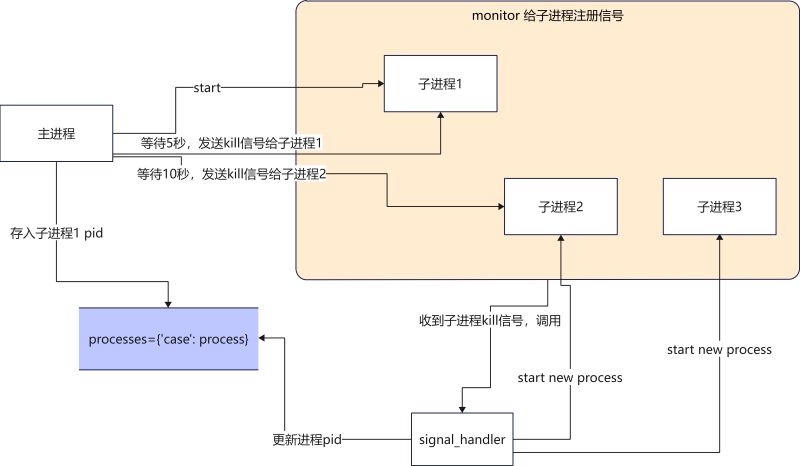背景
由于最近工作需求,需要在已有项目添加一个新功能,实现配置热加载的功能。所谓的配置热加载,也就是说当服务收到配置更新消息之后,我们不用重启服务就可以使用最新的配置去执行任务。
如何实现
下面我分别采用多进程、多线程、协程的方式去实现配置热加载。
使用多进程实现配置热加载
如果我们代码实现上使用多进程, 主进程1来更新配置并发送指令,任务的调用是进程2,如何实现配置热加载呢?
使用signal信号量来实现热加载

当主进程收到配置更新的消息之后(配置读取是如何收到配置更新的消息的? 这里我们暂不讨论), 主进程就向进子程1发送kill信号,子进程1收到kill的信号就退出,之后由信号处理函数来启动一个新的进程,使用最新的配置文件来继续执行任务。
main 函数
|
1
2
3
4
5
6
7
8
9
10
11
12
13
14
15
16
17
18
19
20
|
def main(): # 启动一个进程执行任务 p1 = Process(target=run, args=("p1",)) p1.start() monitor(p1, run) # 注册信号 processes["case100"] = p1 #将进程pid保存 num = 0 while True: # 模拟获取配置更新 print( f"{multiprocessing.active_children()=}, count={len(multiprocessing.active_children())}\n") print(f"{processes=}\n") sleep(2) if num == 4: kill_process(processes["case100"]) # kill 当前进程 if num == 8: kill_process(processes["case100"]) # kill 当前进程 if num == 12: kill_process(processes["case100"]) # kill 当前进程 num += 1 |
signal_handler 函数
|
1
2
3
4
5
6
7
8
9
10
11
12
13
14
15
16
17
18
19
20
21
22
|
def signal_handler(process: Process, func, signum, frame): # print(f"{signum=}") global counts if signum == 17: # 17 is SIGCHILD # 这个循环是为了忽略SIGTERM发出的信号,避免抢占了主进程发出的SIGCHILD for signame in [SIGTERM, SIGCHLD, SIGQUIT]: signal.signal(signame, SIG_DFL) print("Launch a new process") p = multiprocessing.Process(target=func, args=(f"p{counts}",)) p.start() monitor(p, run) processes["case100"] = p counts += 1 if signum == 2: if process.is_alive(): print(f"Kill {process} process") process.terminate() signal.signal(SIGCHLD, SIG_IGN) sys.exit("kill parent process") |
完整代码如下
|
1
2
3
4
5
6
7
8
9
10
11
12
13
14
15
16
17
18
19
20
21
22
23
24
25
26
27
28
29
30
31
32
33
34
35
36
37
38
39
40
41
42
43
44
45
46
47
48
49
50
51
52
53
54
55
56
57
58
59
60
61
62
63
64
65
66
67
68
69
70
71
72
73
74
75
76
77
78
79
80
81
|
#! /usr/local/bin/python3.8from multiprocessing import Processfrom typing import Dictimport signalfrom signal import SIGCHLD, SIGTERM, SIGINT, SIGQUIT, SIG_DFL, SIG_IGNimport multiprocessingfrom multiprocessing import Processfrom typing import Callablefrom data import processesimport sysfrom functools import partialimport timeprocesses: Dict[str, Process] = {}counts = 2def run(process: Process): while True: print(f"{process} running...") time.sleep(1)def kill_process(process: Process): print(f"kill {process}") process.terminate()def monitor(process: Process, func: Callable): for signame in [SIGTERM, SIGCHLD, SIGINT, SIGQUIT]: # SIGTERM is kill signal. # No SIGCHILD is not trigger singnal_handler, # No SIGINT is not handler ctrl+c, # No SIGQUIT is RuntimeError: reentrant call inside <_io.BufferedWriter name='<stdout>'> signal.signal(signame, partial(signal_handler, process, func))def signal_handler(process: Process, func, signum, frame): print(f"{signum=}") global counts if signum == 17: # 17 is SIGTERM for signame in [SIGTERM, SIGCHLD, SIGQUIT]: signal.signal(signame, SIG_DFL) print("Launch a new process") p = multiprocessing.Process(target=func, args=(f"p{counts}",)) p.start() monitor(p, run) processes["case100"] = p counts += 1 if signum == 2: if process.is_alive(): print(f"Kill {process} process") process.terminate() signal.signal(SIGCHLD, SIG_IGN) sys.exit("kill parent process")def main(): p1 = Process(target=run, args=("p1",)) p1.start() monitor(p1, run) processes["case100"] = p1 num = 0 while True: print( f"{multiprocessing.active_children()=}, count={len(multiprocessing.active_children())}\n") print(f"{processes=}\n") time.sleep(2) if num == 4: kill_process(processes["case100"]) if num == 8: kill_process(processes["case100"]) if num == 12: kill_process(processes["case100"]) num += 1if __name__ == '__main__': main() |
执行结果如下
|
1
2
3
4
5
6
7
8
9
10
11
12
13
14
15
16
17
18
19
20
21
22
23
24
25
26
27
28
29
30
31
32
33
34
35
36
37
38
39
40
41
42
43
|
multiprocessing.active_children()=[<Process name='Process-1' pid=2533 parent=2532 started>], count=1processes={'case100': <Process name='Process-1' pid=2533 parent=2532 started>}p1 running...p1 running...kill <Process name='Process-1' pid=2533 parent=2532 started>multiprocessing.active_children()=[<Process name='Process-1' pid=2533 parent=2532 started>], count=1processes={'case100': <Process name='Process-1' pid=2533 parent=2532 started>}signum=17Launch a new processp2 running...p2 running...multiprocessing.active_children()=[<Process name='Process-2' pid=2577 parent=2532 started>], count=1processes={'case100': <Process name='Process-2' pid=2577 parent=2532 started>}p2 running...p2 running...multiprocessing.active_children()=[<Process name='Process-2' pid=2577 parent=2532 started>], count=1processes={'case100': <Process name='Process-2' pid=2577 parent=2532 started>}p2 running...p2 running...multiprocessing.active_children()=[<Process name='Process-2' pid=2577 parent=2532 started>], count=1processes={'case100': <Process name='Process-2' pid=2577 parent=2532 started>}p2 running...p2 running...kill <Process name='Process-2' pid=2577 parent=2532 started>signum=17Launch a new processmultiprocessing.active_children()=[<Process name='Process-2' pid=2577 parent=2532 stopped exitcode=-SIGTERM>], count=1processes={'case100': <Process name='Process-3' pid=2675 parent=2532 started>}p3 running...p3 running...multiprocessing.active_children()=[<Process name='Process-3' pid=2675 parent=2532 started>], count=1 |
总结
好处:使用信号量可以处理多进程之间通信的问题。
坏处:代码不好写,写出来代码不好理解。信号量使用必须要很熟悉,不然很容易自己给自己写了一个bug.(所有初学者慎用,老司机除外。)
还有一点不是特别理解的就是process.terminate() 发送出信号是SIGTERM number是15,但是第一次signal_handler收到信号却是number=17,如果我要去处理15的信号,就会导致前一个进程不能kill掉的问题。欢迎有对信号量比较熟悉的大佬,前来指点迷津,不甚感谢。
采用multiprocessing.Event 来实现配置热加载
实现逻辑是主进程1 更新配置并发送指令。进程2启动调度任务。
这时候当主进程1更新好配置之后,发送指令给进程2,这时候的指令就是用Event一个异步事件通知。
直接上代码
scheduler 函数
|
1
2
3
4
5
6
7
8
9
10
11
12
13
|
def scheduler(): while True: print('wait message...') case_configurations = scheduler_notify_queue.get() print(f"Got case configurations {case_configurations=}...") task_schedule_event.set() # 设置set之后, is_set 为True print(f"Schedule will start ...") while task_schedule_event.is_set(): # is_set 为True的话,那么任务就会一直执行 run(case_configurations) print("Clearing all scheduling job ...") |
event_scheduler 函数
|
1
2
3
4
5
6
7
8
9
|
def event_scheduler(case_config): scheduler_notify_queue.put(case_config) print(f"Put cases config to the Queue ...") task_schedule_event.clear() # clear之后,is_set 为False print(f"Clear scheduler jobs ...") print(f"Schedule job ...") |
完整代码如下
|
1
2
3
4
5
6
7
8
9
10
11
12
13
14
15
16
17
18
19
20
21
22
23
24
25
26
27
28
29
30
31
32
33
34
35
36
37
38
39
40
41
42
43
44
45
46
47
48
49
50
51
52
53
54
55
56
57
|
import multiprocessingimport timescheduler_notify_queue = multiprocessing.Queue()task_schedule_event = multiprocessing.Event()def run(case_configurations: str): print(f'{case_configurations} running...') time.sleep(3)def scheduler(): while True: print('wait message...') case_configurations = scheduler_notify_queue.get() print(f"Got case configurations {case_configurations=}...") task_schedule_event.set() print(f"Schedule will start ...") while task_schedule_event.is_set(): run(case_configurations) print("Clearing all scheduling job ...")def event_scheduler(case_config: str): scheduler_notify_queue.put(case_config) print(f"Put cases config to the Queue ...") task_schedule_event.clear() print(f"Clear scheduler jobs ...") print(f"Schedule job ...")def main(): scheduler_notify_queue.put('1') p = multiprocessing.Process(target=scheduler) p.start() count = 1 print(f'{count=}') while True: if count == 5: event_scheduler('100') if count == 10: event_scheduler('200') count += 1 time.sleep(1)if __name__ == '__main__': main() |
执行结果如下
|
1
2
3
4
5
6
7
8
9
10
11
12
13
14
15
16
17
18
19
20
21
22
|
wait message...Got case configurations case_configurations='1'...Schedule will start ...1 running...1 running...Put cases config to the Queue ...Clear scheduler jobs ...Schedule job ...Clearing all scheduling job ...wait message...Got case configurations case_configurations='100'...Schedule will start ...100 running...Put cases config to the Queue ...Clear scheduler jobs ...Schedule job ...Clearing all scheduling job ...wait message...Got case configurations case_configurations='200'...Schedule will start ...200 running...200 running... |
总结
使用Event事件通知,代码不易出错,代码编写少,易读。相比之前信号量的方法,推荐大家多使用这种方式。
使用多线程或协程的方式,其实和上述实现方式一致。唯一区别就是调用了不同库中,queue和 event.
|
1
2
3
4
5
6
7
|
# threadingscheduler_notify_queue = queue.Queue()task_schedule_event = threading.Event()# asyncscheduler_notify_queue = asyncio.Queue()task_schedule_event = asyncio.Event() |
结语
具体的实现的方式有很多,也各自有各自的优劣势。我们需要去深刻理解到需求本身,才去做技术选型。
以上就是基于Python实现配置热加载的方法详解的详细内容,更多关于Python配置热加载的资料请关注服务器之家其它相关文章!
原文链接:https://www.cnblogs.com/aaron-948/p/16459059.html











